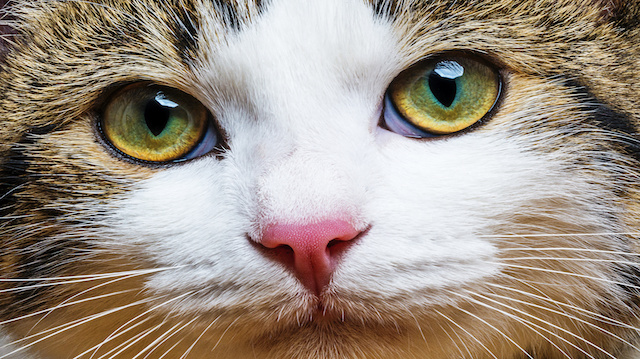
Felines are obligate carnivores, meaning their diet must consist of meat. While it’s theoretically possible to feed a cat a vegan diet and supplement it with nutrients found only in meat, at best a cat will survive. Many become seriously, even fatally, ill. You want your cat to thrive, so make sure to feed him appropriately.
Ethical dilemmas
If you live a vegan lifestyle and do not want to compromise your beliefs by feeding meat to a pet, choose or adopt an animal that doesn’t require meat proteins. These include rabbits, guinea pigs, hamsters and birds. The latter are actually omnivores — in the wild, they eat bugs and worms — but can do well on a plant and seed based diet. Dogs are omnivorous, although their bodies are designed primarily for meat consumption. Under the guidance of a veterinary nutritionist, you can devise a sufficient plant-based diet for canines. However, that’s not the case with cats or another obligate carnivore pet, the ferret.
Kitty’s nutritional needs
In the wild, cats catch and eat rodents, rabbits, and birds. If truly hungry, a cat will eat insects, small reptiles or amphibians. She might also go “fishing” and nab a small specimen. Wild or feral cats are quite efficient. They eat the entire creature, with the exception of an animal’s nails and teeth. If your cat hunts outside, she may leave you a present of a rodent head, or you’ll find the prey’s feet left behind.
Everything else is devoured by the cat in search of a meal. All of that animal protein is utilized. The skeleton provides necessary calcium, while other parts of the prey’s body contain essential nutrients and amino acids. The latter, obtained only from animal protein, includes arginine, which is necessary for eliminating protein waste.
Without sufficient amounts of arginine, dangerous levels of ammonia can build up in the bloodstream of a cat. It doesn’t take long for death to claim a cat lacking arginine. Another essential amino acid, taurine, is crucial to cardiac, retina and fetal health. The National Research Council recommends that the average adult cat receives 12.5 grams of crude protein daily, and 5.5 grams of fat.
No enzymes to break down plant matter
Because cats are designed to eat meat, their digestive tract does not contain the enzymes necessary to properly break down plant matter. Their intestinal tract is quite short, compared to other mammals. If a cat has excessive plant matter in the diet, and no enzymes to break it down, the animal’s pancreas is forced to work overtime.
That’s because the feline pancreas is the only organ that can produce amylase, an enzyme needed for plant digestion. A cat consuming a high-starch diet, as is found in many commercial cat foods, is also prone to developing diabetes.
No home cooking
 You may want to show your love for your cat by making homemade meals for him, with plenty of meat included. Unless you get advice on appropriate ingredients and recipes from a veterinary nutritionist, homemade meals are not a good idea. “It is most difficult to formulate a nutritionally complete and balanced diet with sufficient nutrient density in a small volume of food that is palatable for cats,” according to The Merck Veterinary Manual.
You may want to show your love for your cat by making homemade meals for him, with plenty of meat included. Unless you get advice on appropriate ingredients and recipes from a veterinary nutritionist, homemade meals are not a good idea. “It is most difficult to formulate a nutritionally complete and balanced diet with sufficient nutrient density in a small volume of food that is palatable for cats,” according to The Merck Veterinary Manual.
Homemade cat food may contain plenty of protein, but the all-important calcium-to-phosphorous ratio will likely be out of whack. Homemade feline diets often contain low levels of necessary vitamins, especially B vitamins, and insufficient amounts of iodine or copper. Because many homemade cat food diets require a great deal of supplementation to meet feline nutritional requirements, they may end up containing excessive ash or minerals.
The best way to feed your cat
Since no pet food manufacturers offer “Mouse Mix” for felines, the modern cat’s primary protein sources include poultry, fish and beef. For best results, feed your cat a high-quality, meat-based diet, with few or no grains. If possible, provide wet foods, as these contain a higher meat content than dry foods, along with more protein and fat, and fewer carbohydrates.
Wet foods contain more moisture, helping to keep a cat hydrated. A combination of wet and dry food is also an acceptable option. Cats prefer several small meals a day, rather than receiving their daily ration in one or two servings. And your cat should always have access to clean, fresh water.
—The Alternative Daily
Sources:
http://www.petmd.com/cat/nutrition/evr_ct_cat_nutritional_needs_different
http://feline-nutrition.org/answers/answers-raw-diets-and-cats-what-about-eating-bones
http://www.vcahospitals.com/main/pet-health-information/article/animal-health/taurine-in-cats/3857
http://www.merckvetmanual.com/mvm/management_and_nutrition/nutrition_small_animals/dog_and_cat_foods.html
http://dels.nas.edu/resources/static-assets/materials-based-on-reports/booklets/cat_nutrition_final.pdf

